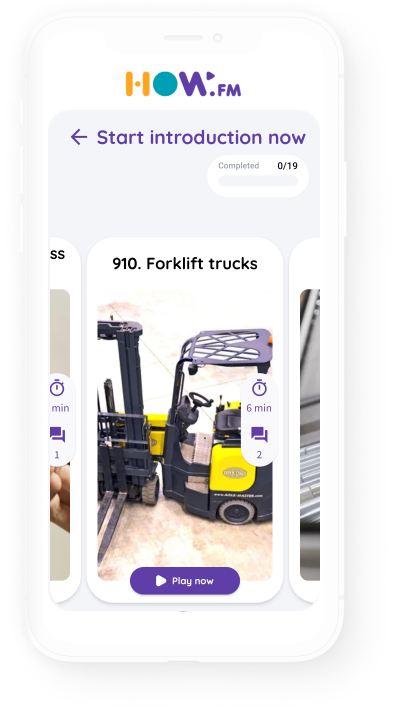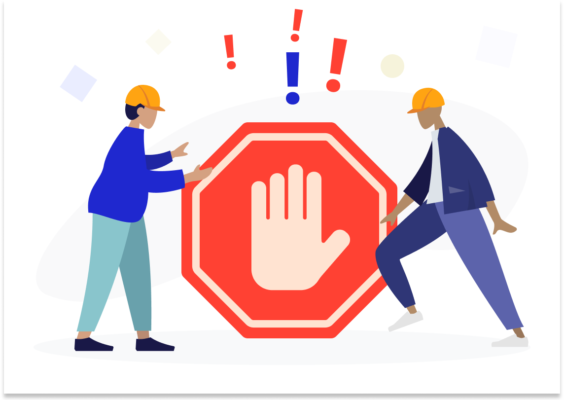Download the General Warehouse Rules and Regulations Safety Compliance Checklist 2022
The number of employees working in warehouses has doubled since 2010, which makes maintaining a safe workplace harder. A quality training program for general warehouse rules and regulations is essential since the rate of fatal injuries for warehouse workers is higher than in all other industries.
A good safety protocol is also critical to your bottom line, the continuation of your company, and avoiding criminal prosecution. OSHA penalties can total more than $14,500 per violation. There is also a hefty cost for compensation when workers are injured. A fall or being caught in machinery can cost over $45,000 per worker.
Similarly, in Germany, OSH can fine businesses up to €25 000 as well as close the company and prosecute owners criminally for failing to comply with safety regulations. Accident insurance inspectors can fine businesses up to €10 000 and raise insurance premiums when OSH performance isn’t up to par.
Here are some general warehouse rules and regulations to inform your protocols and keep your warehouse safe:
Top 10 General Warehouse Rules and Regulations Safety Tips
1. Exercise caution when using forklifts
Forklifts are among the most dangerous warehouse safety hazards, injuring 95,000 employees every year and killing around 100 in the US. The most common cause of injuries due to forklifts is insufficient driver training.
Forklift operators may drive the same route over and over, which can result in a high level of comfort and a temptation to go quickly. However, managers can’t afford to become complacent. Initial forklift training needs to be thorough, and it should be repeated often and whenever non-compliance is observed.
Download: Forklift Pre-Start Checklist Template Here
2. Ensure that workers won’t be caught in conveyors or energized equipment
Workers can be caught in conveyors or struck by objects falling off of a conveyor, especially when they load and unload in close proximity to conveyors. Workers can also be stuck in or pinned by energized equipment if it turns on unexpectedly.
Use safeguarding equipment between conveyors and workers to keep body parts, clothing, or hair from becoming entangled. Training should involve a lockout tagout procedure to keep equipment from turning on when it shouldn’t. The procedure must be followed every time, by every worker.
3. Store materials safely
Stacking materials high and reducing aisle widths can save space in a warehouse, but overhead loads and narrow aisles can result in hazards. Objects pushing out into the aisle can be a tripping hazard. Overhead loads can fall and injure workers.
Stack objects safely with heavier loads on the bottom and lighter loads higher up. Onboarding training should include recommendations on properly storing materials, and improper storage can’t be tolerated.
4. Train workers how to lift and handle material safely and enforce the training
Musculoskeletal disorders (MSDs) are increasingly common. They’re most often caused by repetitive motions but may also occur due to chemical substances, pressure, or disease. Amazon, one of the largest employers of warehouse workers, instated a new program called WorkingWell to address the problem in its warehouses. The program reduced MSD injuries by 32% from 2019 to 2020.
Amazon’s success is a powerful indicator of how training can reduce warehouse safety hazards. Look for ways that procedure and engineering solutions can eliminate unnecessary manual lifting and handling. Train workers in ergonomic posture and correct workers when you see them moving in an unsafe way.
5. Treat hazardous chemicals with respect
Many warehouses store or use hazardous chemicals, which can result in chemical burns, carcinogenic exposure, or respiratory distress if workers handle them inappropriately.
Implement a hazard communication program. Train workers on identifying potentially hazardous chemicals and how to handle, store, and dispose of them properly. Personal protective equipment (PPE) must be readily available and workers trained in how to use it.
6. Protect workers from injury due to sharp objects
Cutting injuries can be problematic in a warehouse environment since workers often pack and unpack objects. Workers should wear proper PPE like gloves and goggles. Safety knives should always be employed during these tasks.
Train workers on how to properly cut materials. If workers rush through cutting jobs, repeat training. Cuts are much more likely when workers are in a rush.
7. Put measures in place to prevent falls
Falls, either from an elevated position or due to slips or trips, are very common. However, these dangers are too often overlooked in safety training topics for warehouse workers. Put into place safety railings, harnesses, and secure ladders. Train your employees on how to use them properly and enforce the training.
8. Avoid having workers injured by vehicles

While forklifts are among the most common causes of injuries in warehouses, other vehicles can also pose a risk. Workers may not be paying attention to their environment as they focus on the task at hand.
Drivers may become very comfortable with their route and drive quickly, resulting in collisions. Make sure that areas where vehicles are driven are clearly marked. Train drivers to go slowly and workers to watch out for vehicles.
9. Practice good fire safety at all times
Warehouses have wide-open spaces where fires can spread easily. Furthermore, they’re frequently filled with materials that can be very flammable, making warehouse fires costly.
Never tolerate smoking around hazardous chemicals, charging stations, and where there are flammable materials. Train employees in where they are and aren’t allowed to smoke and where fire extinguishers are in case of a fire.
10. Prevent workers from overexerting or exhausting themselves
All of the other safety measures on this list are less likely to be effective if your workers are exhausted. People aren’t as mindful of potential dangers when they’re tired. Teach workers how to recognize their own limitations and provide protocols to encourage workers to ask for help or breaks when necessary.
Download the General Warehouse Rules and Regulations Safety Compliance Checklist 2022
There are a lot of things to keep track of to ensure that your warehouse is operating as well as possible. Keeping it all in your head and ensuring you don’t overlook anything can be a challenge. Download this warehouse safety compliance checklist to make sure you don’t overlook anything.
This checklist is easy to post in your office, in break areas, and on the walls of the warehouse. You may find it useful to highlight parts that you find your workers have trouble remembering. You can also go through this checklist regularly or have all managers in your warehouse run through it to ensure that you are staying compliant with all recommendations.
Achieve Warehouse Safety With how.fm
Implement digital safety training. Having difficulty finding time to provide sufficient safety training? Implementing Digital training is a low effort, high reward solution. Using how.fm, you can train new employees quickly, conduct regular training easily, and repeat training for individual workers who are non-compliant as needed. Book a 15-min demo with our training expert to learn more.
Achieve ISO 45001 Certification. This certification verifies that you have a safety management system that works and is sustainable for the long term. It can attract more quality workers during a time when talent can be hard to find. It can also give you confidence that the training system you have in place will keep your warehouse safer despite high turnover, language barriers, and a rapid pace of work.
Safety training that is regular, simple, and effective. Safety training should be clear and consistent. It must keep long-term workers compliant even as they become comfortable in their jobs and ensure that temporary workers understand training right away. Repeat training regularly and whenever workers aren’t complying with training.
